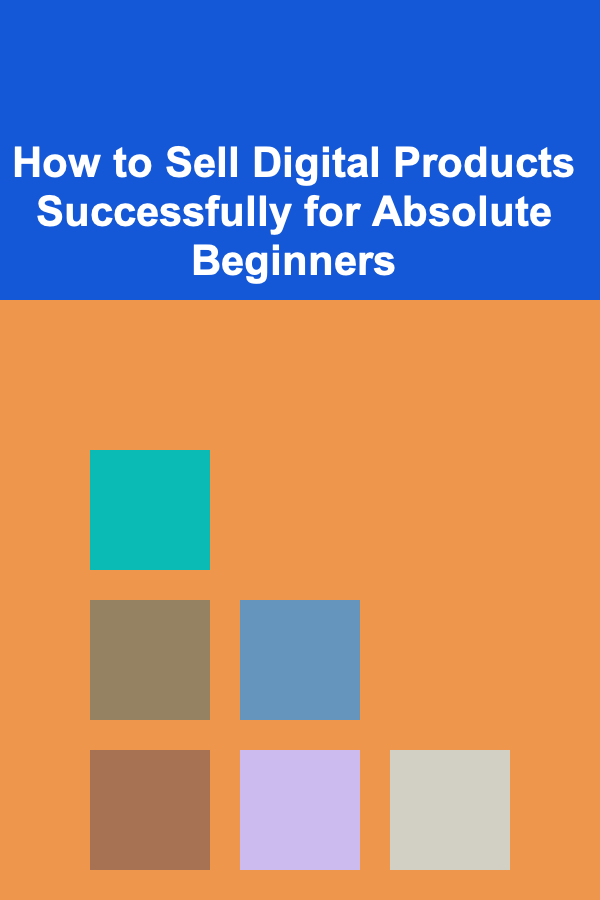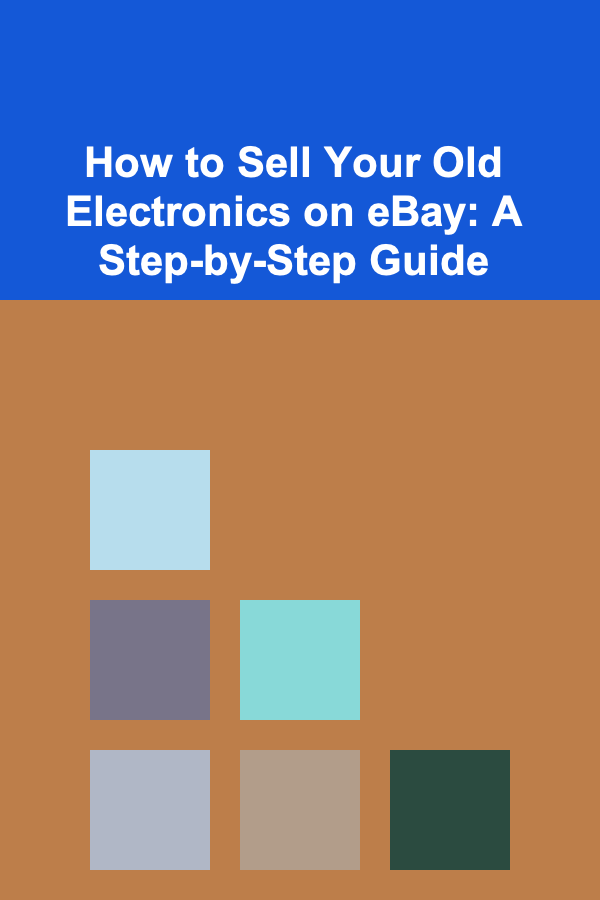
How to Sell Digital Products Successfully for Absolute Beginners
ebook include PDF & Audio bundle (Micro Guide)
$12.99$6.99
Limited Time Offer! Order within the next:

Selling digital products has become a popular business model, offering a pathway to earn passive income, scale your business with minimal overhead, and tap into a global market. Whether you're looking to sell e-books, online courses, software, digital art, or templates, the process of selling digital products can be simple yet effective when approached the right way.
In this actionable guide, we'll cover everything you need to know to successfully sell digital products, from understanding the basics of the business model to marketing your products and managing the logistics. Let's break it down step by step.
Step 1: Identify Your Niche and Product Idea
Before you jump into creating a product, it's essential to identify a niche that resonates with both you and your potential customers. Here's how you can go about it:
1.1. Find Your Passion or Expertise
Your digital product should ideally align with something you're passionate about or knowledgeable in. This makes the process of creating and marketing your product much easier and more enjoyable. Consider areas where you already have expertise or interests --- this could be anything from graphic design to personal finance.
1.2. Analyze Market Demand
Even though passion is important, market demand is equally crucial. To ensure your digital product will sell, it's important to identify whether there's a viable market for it. Here are a few ways to assess demand:
- Research Trends: Use tools like Google Trends to see what people are searching for in your niche.
- Competitor Research: Look at what other sellers in your niche are doing. Analyze their products, pricing, and customer feedback.
- Online Communities: Engage in forums, Facebook groups, Reddit, or other online communities relevant to your niche. See what types of questions people are asking or what problems they need solving.
1.3. Validate Your Idea
Once you've identified your product idea and ensured there's market demand, validate it by testing it on a smaller scale before committing to full-scale production. This could be as simple as running a survey, creating a landing page, or offering a limited version of your product in exchange for feedback.
Step 2: Create Your Digital Product
Now that you've identified your niche and validated your idea, it's time to create your product. The process of product creation varies depending on what you're selling, but here are some general tips for common digital products:
2.1. E-books
Writing an e-book can be a lucrative digital product. Here's how to create and sell an e-book:
- Choose a Relevant Topic: Pick a topic that speaks to your target audience's pain points or interests. It could be how-to guides, self-help, or niche fiction.
- Outline and Write: Break down your content into chapters or sections and create a structured outline. Use tools like Scrivener, Google Docs, or Microsoft Word to write and edit your content.
- Design: Once your content is ready, you can format it professionally. Use Canva or hire a designer to create an attractive cover.
- Export: Save the final version in a format that's accessible, such as PDF, ePub, or MOBI.
2.2. Online Courses
Creating and selling online courses has become an increasingly popular choice. To create a successful course:
- Choose the Right Platform: You can create courses on platforms like Teachable, Thinkific, or Udemy. Alternatively, you could host your courses directly on your website.
- Create Course Content: Develop high-quality video lessons, written material, quizzes, and assignments. Ensure that your content provides real value to your students.
- Presentation Quality: Invest in a good microphone, screen-recording software (e.g., Camtasia, Loom), and a well-lit space for recording your videos.
2.3. Digital Art or Graphics
If you're a designer or artist, selling digital art or graphics can be a great choice:
- Create Unique Designs: You can sell custom illustrations, fonts, templates, or stock photos. Ensure your designs are unique and serve a specific purpose or niche.
- Use Marketplaces: You can sell your digital art on platforms like Etsy, Creative Market, or Gumroad, or build your own website.
- File Formats: Export your designs in common file formats like PNG, JPG, SVG, or PSD to cater to a wide range of customer needs.
2.4. Software or Apps
If you're a developer, creating software or apps is another option:
- Identify a Problem: Develop software that solves a specific pain point for users. It could be anything from a productivity tool to a mobile game.
- Build and Test: Ensure your software is tested for bugs and usability before launching.
- Licensing and Distribution: You can sell software directly through your website, or use platforms like the App Store or Google Play for mobile apps.
Step 3: Set Up an Online Store
To sell digital products, you need an online store where customers can browse and purchase. Here are some key steps to set up your online store:
3.1. Choose a Platform
There are several platforms where you can set up your digital storefront, including:
- E-commerce Websites: Platforms like Shopify, WooCommerce (for WordPress), or BigCommerce allow you to create a fully functional store that integrates with payment processors, cart systems, and digital delivery.
- Digital Marketplaces: You can sell on third-party marketplaces like Etsy, Gumroad, or Creative Market, which handle much of the technical side of selling for you.
- Landing Pages: If you prefer a simpler, low-cost option, you can create landing pages on platforms like Leadpages or ConvertKit to showcase your product and collect payments.
3.2. Set Up Payment Processing
You'll need a way to process payments online. The most popular options are:
- PayPal: A trusted and widely used payment processor that works globally.
- Stripe: A great option for accepting credit cards directly on your website.
- Square: Ideal for both digital and physical product sales.
Ensure that your payment processor is secure and can handle automatic downloads for digital products after purchase.
3.3. Automate Delivery
One of the major advantages of selling digital products is automation. Once someone buys your product, you want them to instantly receive it. Use e-commerce platforms or services like Gumroad or SendOwl that can automatically deliver the digital product to your customer after they make a purchase.
Step 4: Market Your Digital Products
Creating a great digital product is only part of the equation. The real challenge lies in reaching potential customers and driving sales. Here are some actionable marketing strategies:
4.1. Build Your Online Presence
Start by establishing a strong online presence:
- Website/Blog: Build a website where you can showcase your products, provide value through content (e.g., blog posts, tutorials), and capture leads with email sign-ups.
- Social Media: Use platforms like Instagram, Facebook, Pinterest, Twitter, or LinkedIn to reach your audience. Post regularly, interact with your followers, and share behind-the-scenes content to build a connection.
- YouTube: For courses and tutorials, YouTube is a powerful platform. You can create promotional videos or free content to direct traffic to your product.
4.2. Build an Email List
Email marketing is one of the most effective ways to convert visitors into customers:
- Offer Freebies: Give away a free resource (e.g., an e-book, checklist, or mini-course) in exchange for email sign-ups.
- Automated Email Sequences: Set up email sequences that nurture leads and promote your product over time. Platforms like MailChimp, ConvertKit, or ActiveCampaign can help you automate this process.
4.3. Run Paid Ads
Once you have some organic traffic, you can scale your efforts by running paid ads:
- Facebook and Instagram Ads: These platforms allow you to target specific demographics and interests, making them ideal for selling digital products.
- Google Ads: Use Google Search and Display ads to capture potential customers actively searching for solutions related to your product.
- Retargeting Ads: Use retargeting to reach people who visited your site but didn't make a purchase, reminding them of your product.
4.4. Collaborate and Partner with Influencers
Working with influencers or affiliates in your niche can help you reach a wider audience. Influencers can promote your product in exchange for a commission or a flat fee. Make sure to choose influencers whose audience aligns with your target market.
Step 5: Track Performance and Optimize
After launching and promoting your digital product, it's crucial to track performance and continually optimize your strategy.
5.1. Use Analytics
Monitor sales, website traffic, and customer behavior using tools like Google Analytics, Shopify Analytics, or Facebook Insights. Understanding how customers find and interact with your products helps you refine your marketing efforts.
5.2. Collect Customer Feedback
Feedback from customers is invaluable. It can help you improve your product, fix issues, and identify opportunities for new products. Encourage reviews and ratings, and be responsive to customer questions and concerns.
5.3. Test and Optimize
Try out different pricing strategies, sales funnels, and marketing messages to see what works best for your audience. A/B testing can be incredibly useful in determining which ads, landing pages, or product offerings perform better.
Conclusion
Selling digital products can be incredibly rewarding, but it requires careful planning, market research, and consistent effort. By following these actionable steps --- from selecting a niche to marketing your product and optimizing for success --- you'll be well on your way to launching and growing a profitable digital product business.
The key to success lies in offering value, building relationships with your audience, and continually adapting to the market's needs. With patience and persistence, you can create a thriving digital product business that offers flexibility, passive income, and the ability to scale globally.

How to Create a Kid-Friendly Homework Station
Read More
How to Create a Monthly Investment Plan
Read More
How to Create a Year-Round Home Maintenance Schedule
Read More
How to Keep Your Drawer Tools Clean and Organized
Read More
How to Sell Your Old Electronics on eBay: A Step-by-Step Guide
Read More
How to Stage Your Home to Sell in a Competitive Market
Read MoreOther Products

How to Create a Kid-Friendly Homework Station
Read More
How to Create a Monthly Investment Plan
Read More
How to Create a Year-Round Home Maintenance Schedule
Read More
How to Keep Your Drawer Tools Clean and Organized
Read More
How to Sell Your Old Electronics on eBay: A Step-by-Step Guide
Read More